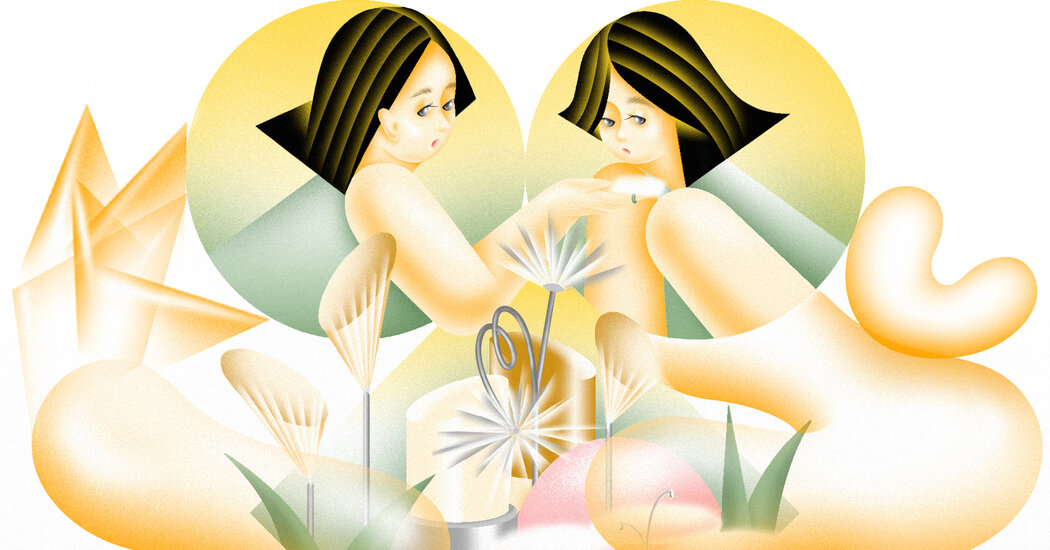
A simple scroll on TikTok reveals that contouring is back from the dead.
It is back after a backlash against the sculpted, drawn-on look often associated with the early 2000s. (Remember strobing? Baking?) It is back after a pandemic in which many people swore off makeup altogether. But the look is not what you may remember.
Makeup mavens are now sweeping bronzer, blush and highlighter underneath their foundation for a look that’s called under painting. It’s an approach makeup artists have used for years to create a “natural” look: All of the color goes on first, and the foundation acts as a veil to diffuse it. Sometimes the look is referred to as soft sculpting. The idea is to choose lighter formulas, apply less and blend more.
With a new contouring in mind, companies like Glossier and Undone Beauty have released water-light, creamy formulas. For example, Glossier’s Solar Paint, described as an “almost whipped gel crème,” is a textured bronzer meant for applying with the fingertips. Undone’s Water Bronzer is a water-based stick designed to create a soft contour that blends seamlessly.
The upshot is that many young women who may have witnessed the heavy contouring of earlier days are trying it for the first time.
“I’m 26 years old and just three months ago I started contouring,” said Madison Baber, a brand activation manager in San Antonio. She was inspired by TikTok influencers like Kylie Larson and Kensy Tillo who came across her For You page and who made contouring look “so easy and natural.”
“I saw how it can transform your face but not make you look caky,” Ms. Baber said.
Fabiana Meléndez Ruiz, 26, is also a newbie. “I literally started contouring in September,” said Ms. Ruiz, who works in marketing. “I had never done it previously, even though I lived through the 2015, 2016 YouTube chaos of extreme contouring.”
Madison Beer’s Vogue Beauty Secrets video was the turning point for Savannah Scott, the editor of the beauty review app Supergreat. “She talks about how Charlotte Tilbury’s contour wand changed her life,” Ms. Scott, 28, said of the 22-year-old influencer and singer. “When I watched how she used it, I thought, ‘I can do this.’”
“I was looking to contour because I know how transformative it can be for someone’s face,” Ms. Scott said.
Kim Kardashian’s longtime makeup artist Mario Dedivanovic, who largely popularized the once obscure photo shoot technique, is all in.
“I’ve definitely seen contour shift to a softer look,” Mr. Dedivanovic said. “People who are trying it for the first time are looking for a softer, more effortless way to wear it, and there’s less pressure to follow all the rules.”
The more intimidating contour looks of the past were really intended for social media, YouTube and heavy lighting, he said.
The new wave of contouring has a lot to do with the current style obsession with the 1990s. The OG supermodels of that era had defined cheekbones and strong jaw lines, but the look was more natural and less obvious than that of the early aughts.
“Now that all things ’90s have made a big comeback, the contour aesthetic from that era is no exception, except we’re seeing it more scaled back for everyday,” Mr. Dedivanovic said.
The makeup artist Charlotte Tilbury is so enamored of the contour look of the ’90s that she created an entire contour palette devoted to it, called the Nudegasm Face Palette.
“I started my career in the ’90s, surrounded by the goddess supers who truly understood the power of tone-on-tone color layering to play up their features,” Ms. Tilbury said. “From Cindy and Naomi to Kate and Linda, it was all about magic matte formulas to create a soft, diffused contour.” That was the beauty philosophy of the ’90s, she said — enhancing one’s own features by playing with light and shade.
Some makeup professionals suggest that the new wave of contouring came about because of boredom with the highly filtered, altered look we’ve become accustomed to on social media.
“We’re moving away from using bronzers and highlighters to sculpt the angles of the face,” said Terri Bryant, a makeup artist and the founder of Guide Beauty, a line of makeup products created with accessibility in mind. “I’m a huge fan of returning to makeup focused on celebrating and enhancing our features versus altering them.”
For anyone thinking of tapping into the trend, the new, lighter products are a great way to start, but the application is important, too. Ms. Bryant prefers using different shades of cream blushes rather than bronzers for contouring.
“Start with the cheeks,” she said. “It’s a larger area to work with and a good place to hone your blending skills. You highlight the cheekbone by adding a lighter, multidimensional shade to attract light. It’s like putting a spotlight directly on the feature. To contour, apply a matte shade, no more than one or two shades deeper than your natural skin tone, in the hollow area just under the cheekbone.”
The darker shading makes that area appear to recede, ultimately lifting and defining the cheekbone above it.
Ms. Tilbury advises thinking simply as well. “Just think of contouring as choosing the features you most want to showcase through the use of light and shade,” she said.
She credits the new look of contouring to new products. “There’s a softer, more modern take on contouring as the formulas and looks have evolved,” she said. “Now it’s all about a flattering contour — super-forgiving, finely milled powders that don’t sit in your lines and pores and creamy, lightweight formulas that allow effortless blending.”
For supermodel cheekbones reminiscent of the ’90s, she said, follow the cheek’s hollow, suck in your cheeks, nestle the brush into the hollow and brush backward and forwards.
“Always remember to blend, blend, blend,” Ms. Tilbury said.






